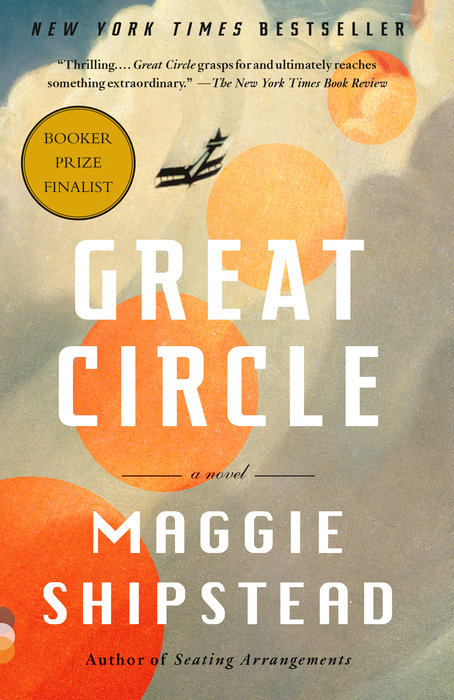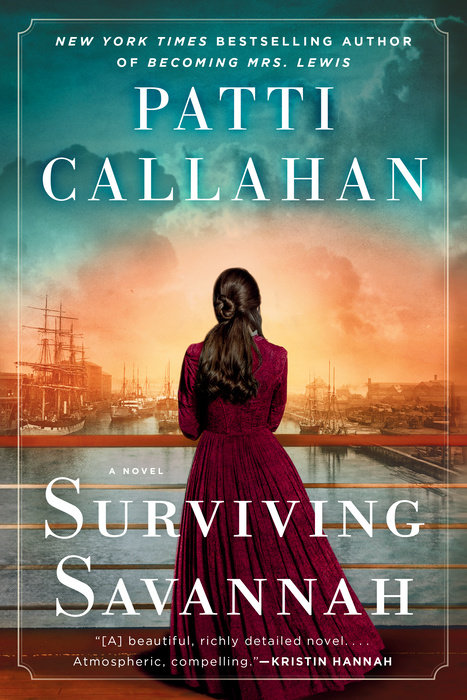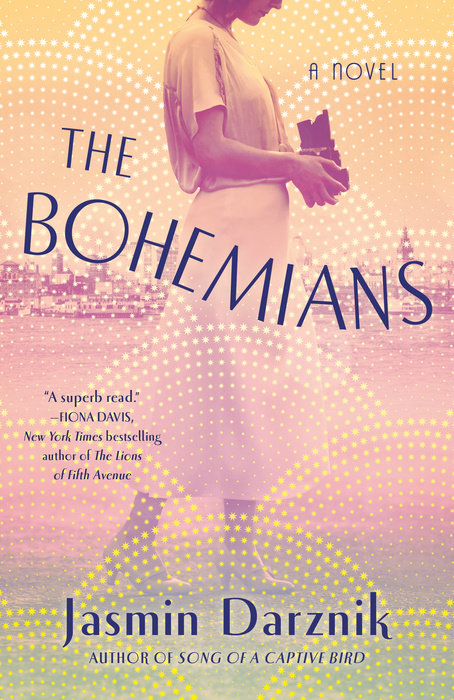With Spring finally here, it’s time for new beginnings. And these ten titles, all new to paperback this April, deliver stories of protagonists embarking on new adventures, whether they be ones of love, recovery, or self-discovery. From a historical nonfiction portrait redefining a well-known figure to inventive reimaginings in history, to sweeping sagas and intimate stories, these selections show the range of what it means to start again, start over, or uncover a truth.

New in Paperback: 10 April Releases to Light Up Your Life
LEONORA IN THE MORNING LIGHT illuminates a long-overlooked history of a fascinating and empowering female artist. In 1937, British socialite and aspiring painter Leonora Carrington follows Max Ernst, a famed, older, and married artist, to Paris. There, he introduces her to the leading figures of the Surrealist movement. Inspired, Leonora’s own artistic pursuits take flight. But when Max, a German citizen, and his friends are arrested as degenerates, during WWII, Leonora must survive the war alone. Years later, Leonora struggles to become recognized as an artist in her own right in this enlightening historical novel.
*One of Oprah Daily’s Most Anticipated Historical Fiction Novels That Will Sweep You Away*
“Michaela Carter’s training as a poet and painter shines through from the first page of this vivid, gorgeous novel based on the lives of Leonora Carrington and Max Ernst. Told with all the wild magic and mystery of the Surrealists themselves, Leonora in the Morning Light fearlessly illuminates the life and work of a formidable female artist.” —Whitney Scharer, bestselling author of The Age of Light
For fans of Amy Bloom’s White Houses and Colm Tóibín’s The Master, a “gorgeously written, meticulously researched” (Jillian Cantor, bestselling author of Half Life) novel about Surrealist artist Leonora Carrington and the art, drama, and romance that defined her coming-of-age during World War II.
1940. A train carrying exiled German prisoners from a labor camp arrives in southern France. Within moments, word spreads that Nazi capture is imminent, and the men flee for the woods, desperate to disappear across the Spanish border. One stays behind, determined to ride the train until he reaches home, to find a woman he refers to simply as “her.”
1937. Leonora Carrington is a twenty-year-old British socialite and painter when she meets Max Ernst, an older, married artist whose work has captivated Europe. She follows him to Paris, into the vibrant world of studios and cafes where rising visionaries of the Surrealist movement like Andre Breton, Pablo Picasso, Lee Miller, Man Ray, and Salvador Dali are challenging conventional approaches to art and life. Inspired by their freedom, Leonora begins to experiment with her own work, translating vivid stories of her youth onto canvas and gaining recognition under her own name. It is a bright and glorious age of enlightenment—until war looms over Europe and headlines emerge denouncing Max and his circle as “degenerates,” leading to his arrest and imprisonment. Left along as occupation spreads throughout the countryside, Leonora battles terrifying circumstances to survive, reawakening past demons that threaten to consume her.
As Leonora and Max embark on remarkable journeys together and apart, the full story of their tumultuous and passionate love affair unfolds, spanning time and borders as they seek to reunite and reclaim their creative power in a world shattered by war. When their paths cross with Peggy Guggenheim, an art collector and socialite working to help artists escape to America, nothing will be the same.
Based on true events and historical figures, Leonora in the Morning Light is “a deeply involving historical tale of tragic lost love, determined survival, the sanctuary of art, and the evolution of a muse into an artist of powerfully provocative feminist expression” (Booklist, starred review).
In this New York Times bestselling epic, Marian Graves—raised by her uncle in early 1900s Montana—falls in love at an early age with flight. A dangerous agreement with a wealthy patron gets Marian into flight school and subsidizes her flights across the globe, but this freedom comes at a cost. More than a half century after Marian disappears over Antarctica, actress Hadley Baxter—determined to reset her career after a constraining romantic film franchise—is excited to play her in a biopic. As the two women are juxtaposed, Maggie Shipstead explores a complex and thrilling tale of female ambition and determination.
On a Saturday in 1944, a crowd of shoppers are killed in an explosion on Bexford High Street in South London. Among the fatalities are five children. In this profound and moving reimagining, inspired by a real event, Francis Spufford unspools an alternative history of all five children as if they’d lived. Following them through the cultural transformations taking place in mid-twentieth century London and into their adult lives, LIGHT PERPETUAL dips in and out of the intimate lives of the five characters, revealing their personal triumphs, and their lasting disappointments.
Named a Best Book of the Year by The New York Times, NPR, Slate, Lit Hub, Fresh Air, and more
From the critically acclaimed and award‑winning author of Golden Hill, an “extraordinary…symphonic…casually stunning” (The Wall Street Journal) novel tracing the infinite possibilities of five lives in the bustling neighborhoods of 20th-century London.
Lunchtime on a Saturday, 1944: the Woolworths on Bexford High Street in South London receives a delivery of aluminum saucepans. A crowd gathers to see the first new metal in ages—after all, everything’s been melted down for the war effort. An instant later, the crowd is gone; incinerated. Among the shoppers were five young children.
Who were they? What futures did they lose? This brilliantly constructed novel, inspired by real events, lets an alternative reel of time run, imagining the lives of these five souls as they live through the extraordinary, unimaginable changes of the bustling immensity of twentieth-century London. Their intimate everyday dramas, as sons and daughters, spouses, parents, grandparents; as the separated, the remarried, the bereaved. Through decades of social, sexual, and technological transformation, as bus conductors and landlords, as swindlers and teachers, patients and inmates. Days of personal triumphs and disasters; of second chances and redemption.
Ingenious and profound, full of warmth and beauty, Light Perpetual “offers a moving view of how people confront the gap between their expectations and their reality” (The New Yorker) and illuminates the shapes of experience, the extraordinariness of the ordinary, the mysteries of memory, and the preciousness of life.
With her married life, teenage daughter, comfortable home, and busy volunteer schedule, Daisy knows she has a good life. Still, she is restless with a desire she can’t quite articulate. Then, she begins receiving emails meant for Diana, a woman whose email address is only one punctuation mark different from hers. Diana, it seems, runs a glamorous, busy life as a single woman in Philadelphia. When the two women finally meet and become friends, Daisy begins to discover there is more to their accidental connection than first meets the eye in this story of female friendship—and an elaborate ruse—by beloved author Jennifer Weiner.
From the #1 New York Times bestselling author of Big Summer and “undisputed boss of the beach read” (The New York Times) comes another timely and deliciously twisty novel of intrigue, secrets, and the transformative power of female friendship.
Daisy Shoemaker can’t sleep. With a thriving cooking business, full schedule of volunteer work, and a beautiful home in the Philadelphia suburbs, she should be content. But her teenage daughter can be a handful, her husband can be distant, her work can feel trivial, and she has lots of acquaintances, but no real friends. Still, Daisy knows she’s got it good. So why is she up all night?
While Daisy tries to identify the root of her dissatisfaction, she’s also receiving misdirected emails meant for a woman named Diana Starling, whose email address is just one punctuation mark away from her own. While Daisy’s driving carpools, Diana is chairing meetings. While Daisy’s making dinner, Diana’s making plans to reorganize corporations. Diana’s glamorous, sophisticated, single-lady life is miles away from Daisy’s simpler existence. When an apology leads to an invitation, the two women meet and become friends. But, as they get closer, we learn that their connection was not completely accidental. Who IS this other woman, and what does she want with Daisy?
From the manicured Main Line of Philadelphia to the wild landscape of the Outer Cape, written with Jennifer Weiner’s signature wit and sharp observations, That Summer is a “compelling, nuanced novel” (Maureen Corrigan, The Washington Post) about surviving our pasts, confronting our futures, and the sustaining bonds of friendship.
Savannah history professor Everly Winthrop has been asked to curate a museum collection of newly discovered artifacts from the Pulaski, a steamship that sank in 1838, with most of the city’s elite onboard. As Everly digs deeper in her research, she uncovers the stories of Augusta Longstreet and Lilly Forsyth—one of whom survived the ship’s sinking while the other was never found. Through Everly’s work, the devastating shipwreck, little known, comes to fascinatingly detailed historical life.
From award-winning author Carys Davies comes a story of cultural misunderstandings and divisions in a present still coping with an imperial past. Hilary Byrd withdraws from contemporary life in England to live in a British hill station in south India. There, he befriends the local Padre and his adoptive daughter Priscilla and begins to wonder if his future purpose resides with them. But as local religious tensions come to a head, the mission house proves not to be the haven Hilary imagined it to be.
The Sunday Times (London) 2020 Novel of the Year
“Luminous…a writer to watch—and to savor.” —Oprah Daily
From the award-winning author of West and The Redemption of Galen Pike, a “sublime” (The Toronto Star) and propulsive novel that follows an Englishman seeking refuge in a remote hill town in India who gets caught in the crossfire of local tensions.
In this “jewel of a novel” (The Observer), Hilary Byrd flees his demons and the dark undercurrents of contemporary life in England for a former British hill station in south India. Charmed by the foreignness of his new surroundings and by the familiarity of everything the British have left behind, he finds solace in life’s simple pleasures, travelling by rickshaw around the small town with his driver Jamshed and staying in a mission house beside the local presbytery where, after a chance meeting, the Padre and his adoptive daughter Priscilla take Hilary under their wing.
The Padre is concerned for Priscilla’s future, and as Hilary’s friendship with the young woman grows, he begins to wonder whether his purpose lies in this new relationship. But religious tensions are brewing and the mission house may not be the safe haven it seems.
A “skillful drama of well-meant misunderstandings and cultural divisions” (The Wall Street Journal), The Mission House boldly and imaginatively explores postcolonial ideas in a world fractured between faith and nonbelief, young and old, imperial past and nationalistic present. Tenderly subversive and meticulously crafted, it is a deeply human story of the wonders and terrors of connection in a modern world.
Devastated after a series of miscarriages, Gail Durbin, along with her husband, is determined to adopt. But her determination becomes desperation after several adoptions fall through. Meanwhile, Carli, a pregnant teenager from a working-class background, is eager to go to college and escape her hometown. While making the decision to give her child up for adoption was hard, Carli believes the Durbins are the right fit for her baby. However, Marla, Carli’s mother, has other plans for her new granddaughter. In this emotional and suspenseful novel, three mothers’ wills converge on a heartbreaking collision course.
An “engrossing debut” novel (Laura Dave, New York Times bestselling author of The Last Thing He Told Me) about a couple whose dreams of adoption push them to do the unthinkable when their baby’s birth family steps into the picture.
HOW FAR WOULD YOU GO TO SAVE YOUR FAMILY?
As soon as Gail and Jon Durbin bring home their adopted baby Maya, she becomes the glue that mends their fractured marriage.
But the Durbin’s social worker, Paige, can’t find the teenage birth mother to sign the consent forms. By law, Carli has seventy-two hours to change her mind. Without her signature, the adoption will unravel.
Carli is desperate to pursue her dreams, so giving her baby a life with the Durbins seems like the right choice—until her own mother throws down an ultimatum. Soon Carli realizes how few choices she has.
As the hours tick by, Paige knows that the Durbins’ marriage won’t survive the loss of Maya, but everyone’s life is shattered when they—and baby Maya—disappear without a trace.
Filled with heartrending turns, Other People’s Children is a riveting page-turner you’ll find impossible to put down.
In 1920, Eleanor Roosevelt withdrew from her duties as a mother of five to move to the transgressive and explosive Greenwich Village. Joining a cohort called “The New Women,” Roosevelt became engaged in their agenda for social change, advocating for everything from unions to equal pay to sexual freedom. Jan Jarboe Russell’s impeccable research and intimate writing captures this transformative moment in Roosevelt’s life, exploring the desire that brought her to the Village and the lasting influence it had on her political legacy.
A “riveting and enlightening account” (Bookreporter) of a mostly unknown chapter in the life of Eleanor Roosevelt—when she moved to New York’s Greenwich Village, shed her high-born conformity, and became the progressive leader who pushed for change as America’s First Lady.
Hundreds of books have been written about FDR and Eleanor, both together and separately, but yet she remains a compelling and elusive figure. And, not much is known about why in 1920, Eleanor suddenly abandoned her duties as a mother of five and moved to Greenwich Village, then the symbol of all forms of transgressive freedom—communism, homosexuality, interracial relationships, and subversive political activity. Now, in this “immersive…original look at an iconic figure of American politics” (Publishers Weekly), Jan Russell pulls back the curtain on Eleanor’s life to reveal the motivations and desires that drew her to the Village and how her time there changed her political outlook.
A captivating blend of personal history detailing Eleanor’s struggle with issues of marriage, motherhood, financial independence, and femininity, and a vibrant portrait of one of the most famous neighborhoods in the world, this unique work examines the ways that the sensibility, mood, and various inhabitants of the neighborhood influenced the First Lady’s perception of herself and shaped her political views over four decades, up to her death in 1962.
When Eleanor moved there, the Village was a zone of Bohemians, misfits, and artists, but there was also freedom there, a miniature society where personal idiosyncrasy could flourish. Eleanor joined the cohort of what then was called “The New Women” in Greenwich Village. Unlike the flappers in the 1920s, the New Women had a much more serious agenda, organizing for social change—unions for workers, equal pay, protection for child workers—and they insisted on their own sexual freedom. These women often disagreed about politics—some, like Eleanor, were Democrats, others Republicans, Socialists, and Communists. Even after moving into the White House, Eleanor retained connections to the Village, ultimately purchasing an apartment in Washington Square where she lived during World War II and in the aftermath of Roosevelt’s death in 1945.
Including the major historical moments that served as a backdrop for Eleanor’s time in the Village, this remarkable work offers new insights into Eleanor’s transformation—emotionally, politically, and sexually—and provides us with the missing chapter in an extraordinary life.
Natalie Seebring has spent her life crafting appearances, from her perfect marriage to her successful vineyard. But when Natalie marries a vineyard employee just months after her husband’s death, everyone in her life—including her adult children—is appalled. To help write an appearance-saving memoir, Natalie hires Olivia, who is eager to use the job to give herself and her ten-year-old daughter a summer of fantasy at the matriarch’s Rhode Island vineyard. But as the two women, a generation apart, get closer, Olivia discovers not all is what it seems in this powerful story by New York Times bestselling author Barbara Delinsky.
From the New York Times bestselling author of the “delicious beach read” (Booklist) A Week at the Shore, a moving and timeless tale of two women, a generation apart, whose dreams meet in an unexpected way.
To her family, Natalie Seebring is a woman who values appearance above all else as an exquisitely mannered, supportive wife and head of a successful wine-producing enterprise. So when she announces plans to marry a vineyard employee mere months after the death of her husband, her children are stunned. Faced with their disapproval, Natalie decides to write a memoir to fully explain.
Olivia Jones is a dreamer, living vicariously through the old photographs she restores. She and her daughter cling to the fantasy that a big, happy family is out there just waiting for them. When Natalie hires Olivia to help with her memoir, a summer at Natalie’s vineyard by the sea seems the perfect opportunity to live out that fantasy. But all is not as it appears to be.
As the illusion of an idyllic existence comes crashing into reality, the lives of two women, parallel in so many ways, collide in a way that will change both of them forever.
In this absorbing, glittering reimagining of the Jazz Age in San Francisco, photographer Dorothea Lange, as a young woman, moves to the city in 1918, eager to overcome her naivety and make it in the art world. Her new, straight-talking friend Caroline Lee introduces her to a bohemian artist’s colony, where Dorothea experiences a world of personal and political awakening. She falls in love with painter Maynard Dixon and discovers her own talent, which will make her the iconic Depression Era photographer we know today. An irresistibly charming historical novel based on a famous American master with a camera.
Photo credit: iStock / Jelena990





















